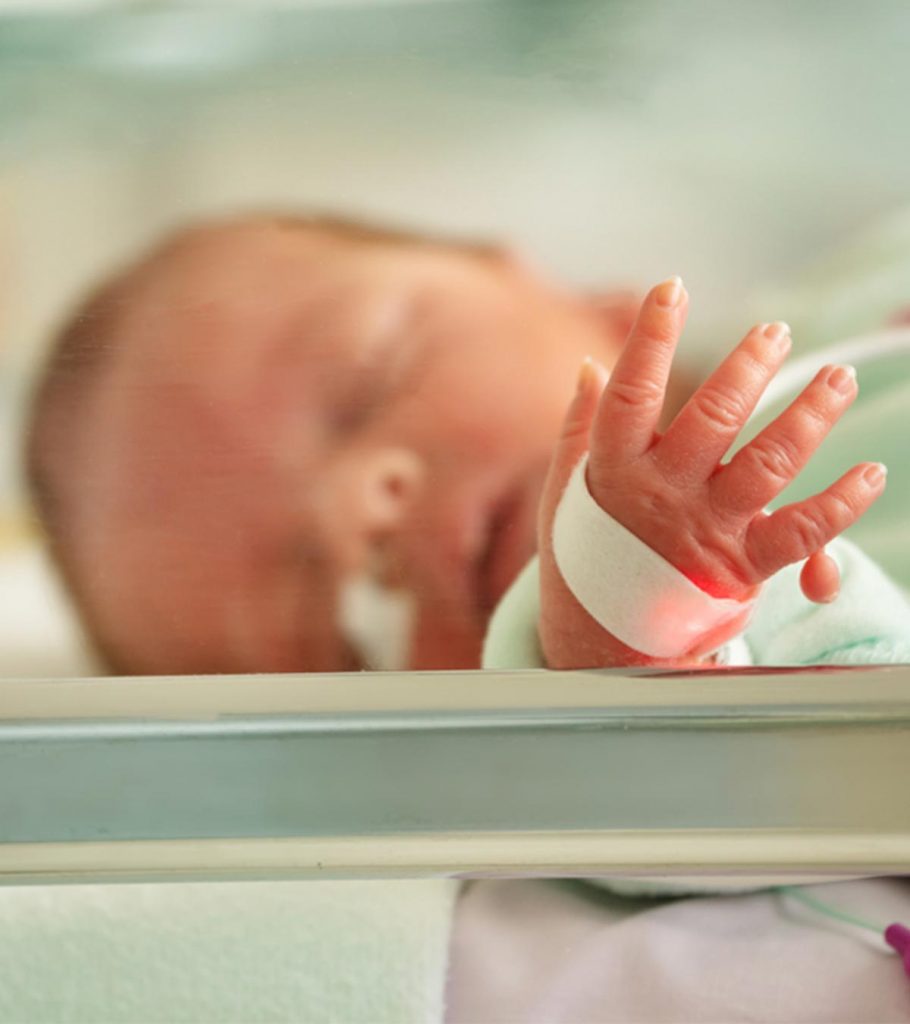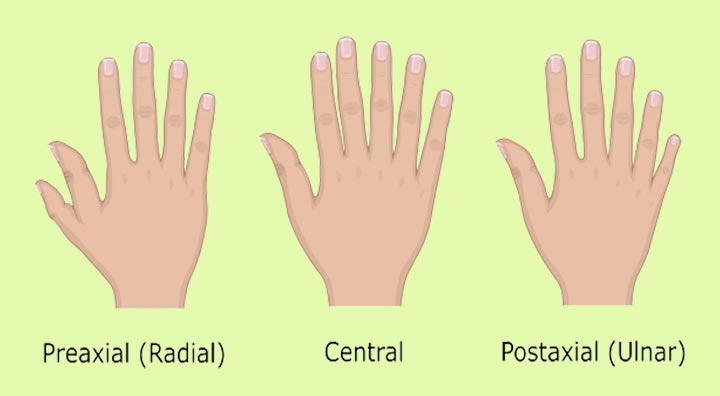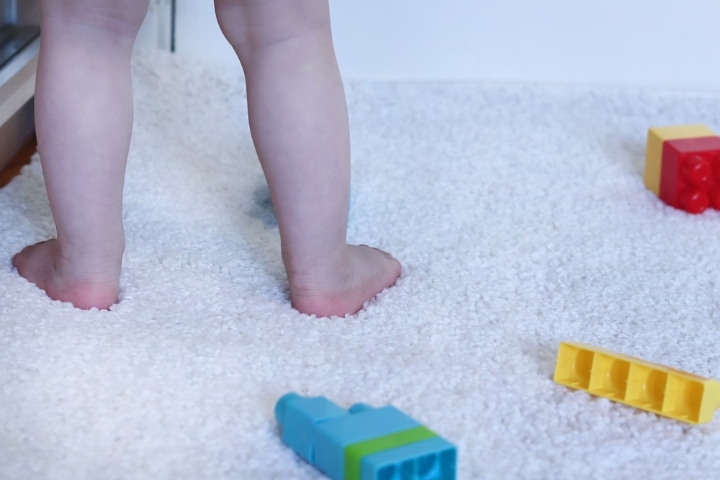Polydactyly in babies occurs in 1 in every 1000 babies and is a congenital condition where the baby has an extra finger or toe. The extra digit is called a supernumerary digit. The extra digit, toe or finger, may be poorly developed or fully formed. In several babies, the extra digit can be poorly formed and smaller than the others.
Polydactyly is usually most commonly seen on foot (extra toes). However, it may also occur on hands, feet, or both.
Causes Of Polydactyly In Babies
Isolated or non syndromic polydactyly occurs without other genetic issues. It may occur due to random genetic mutations or positive family history of polydactyly. Syndromic polydactyly occurs in conjunction with other genetic conditions or syndromes, such as those mentioned below (1).
- Patau syndrome (Trisomy 13)
- Carpenter syndrome
- Bardet–Biedl syndrome
- Rubinstein-Taybi syndrome
- Smith-Lemli-Opitz syndrome
- Jeune syndrome
- Ellis-van Creveld syndrome
Types Of Polydactyly
Polydactyly (digit duplication) is a congenital anomaly (birth defect) that can be classified into three types depending on the location of the extra digit (2).
- Preaxial polydactyly is when the extra digit is outside the big toe or thumb. It is called radial polydactyly (thumb duplication) if outside the thumb and tibial polydactyly (big toe duplication) if outside the big toe.
- Postaxial polydactyly is when the extra digit is outside the little toe or little finger. This is called ulnar polydactyly if the extra digit is outside the little finger and fibular polydactyly if it is outside the little toe. This type is common in African American babies and most likely to run in families.
- Central polydactyly is when an extra digit is located between the toes or fingers.
Babies could have one type of polydactyly or multiple types of polydactyly at a time.
Signs And Symptoms Of Polydactyly
Babies with polydactyly are born with one or more extra toes or fingers. A small bump or flap of skin that looks like a finger can be seen in some babies. These are called nubbins that are underdeveloped extra fingers or toes with a lack of functionality. In contrast, some babies may have fully developed extra fingers or toes that can function normally. Polydactyly can also be associated with other hand or toe malformations, such as syndactyly (3).
Isolated polydactyly may not show any other signs or symptoms than an extra finger or toe. If polydactyly is associated with other syndromes, you may notice clinical signs and symptoms specific to it.
Some babies may have polysyndactyly, which is a combination of syndactyly (fused or webbed fingers or toes) and polydactyly. This may require more complex procedures to reshape the hand or foot.
Diagnosis Of Polydactyly
Prenatal ultrasound may show extra fingers or toes in a fetus, although it may not be clearly evident in all fetuses. Postnatal checkup could determine the presence of an extra finger or toe or the presence of nubbins.
X-ray examinations of the limb are ordered to look for the presence and extent of the limb deformity such as bone in the extra digit. This may also help to understand how the extra digit is connected to other fingers or toes on the hand or foot. Pediatricians may also order blood tests and genetic tests to look for chromosomal abnormalities and associated syndromes’ clinical features (3).
Treatment For Polydactyly In Babies
The treatment involves the surgical removal of the extra digit. The removal may be necessary if the extra finger or toe causes complications or interferes with the hand or foot functions. If the extra digit has no potential to cause problems, it may be left intact. Some parents may prefer removal for cosmetic reasons.
The surgery may vary depending on the tissues of the extra digit and how it is connected to other fingers or toes, muscles, bones, and other parts of the hand or foot. The following methods are often used for extra digit removal (4).
- Vascular clips are used for poorly developed digits without bone. Extra digits fall off due to lack of blood supply after placing a vascular clip on its base. Tying off or ligation can also be used for this purpose. The procedure is done after expert examination and requires follow-ups as recommended by the pediatrician.
- Surgery is required to remove fully formed extra fingers or toes. Surgical removal is usually done around one year of age. The complexity of surgery may vary based on how the extra digit is connected to the surrounding tissues. Some may require reconnection of some structures after removing the extra digit to sustain the hand or foot’s normal structure and function.
Follow-up visits are often scheduled after the procedure to evaluate healing progress. Some babies might require occupational therapy to achieve normal functions if they underwent extensive surgery to correct polydactyly. Babies with other genetic syndromes may also require further treatment for their conditions.
Complications Of Polydactyly
Polydactyly in babies when it affects the toes may lead to the following complications.
- Hallux varus (deviation of the toe) is a common complication of polydactyly. This may cause pain and need surgical correction by capsulorrhaphy (tightening of the joint capsule).
- Shoes may not fit correctly due to extra toes in some babies. This may cause pain and discomfort when they begin to walk.
- Angular deformities, such as bowing of metatarsal (bone of the foot) or angulation of MTP joint (joint in the foot), may occur in some cases.
- Polydactyly may increase the risk for MTP subluxation (partial dislocation of joints).
Polydactyly affecting the fingers can result in difficulty writing or using the hands for common tasks. There is also risk of infection, pain at the site, and decreased function following surgical correction.
Some babies may not develop complications, while others with uncorrected polydactyly could also face problems with writing, walking, and other skills that require the use of hands and feet.
Polydactyly on babies is a congenital condition when the babies are born with extra toes or fingers. Some babies may have isolated polydactyly without any genetic syndromes due to random changes during development, while some may have coexisting genetic syndromes such as Patau syndrome or carpenter syndrome. Some babies can have the extra finger fused or wedded to the other finger. The treatment options are planned according to imaging studies. Extra fingers without bones can be removed through vascular clipping, and fingers with bones require surgical methods. . Isolated congenital anomalies that do not interfere with normal development and quality of life can be left unmanaged.
Key Pointers
- Some of the causes for polydactyly or extra fingers in babies are Patau syndrome, Carpenter syndrome, and Jeune syndrome.
- Polydactyly could be of three types: preaxial, central, and postaxial polydactyly.
- It can be diagnosed during prenatal and postnatal ultrasounds or an X-ray.
- It can be treated with vascular clips or surgery based on the condition.
Witness the examination of a rare case of polydactyly in a newborn by a medical professional and gain important insights and information about this condition.















